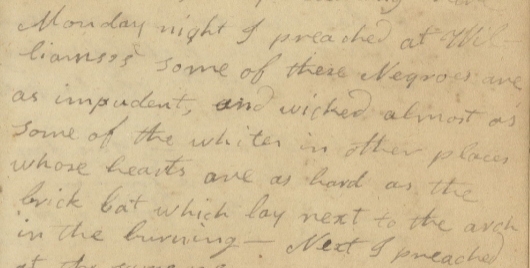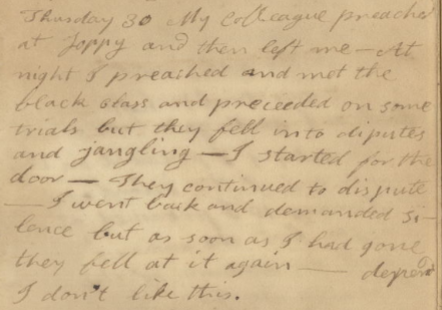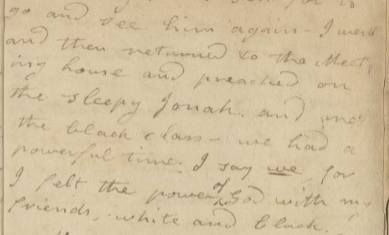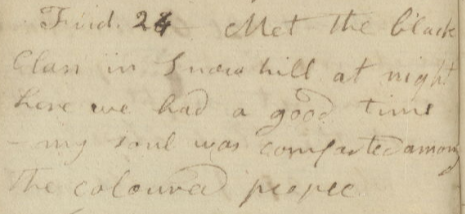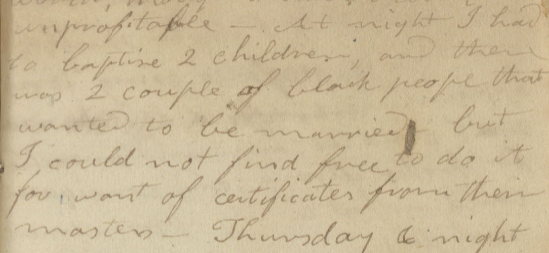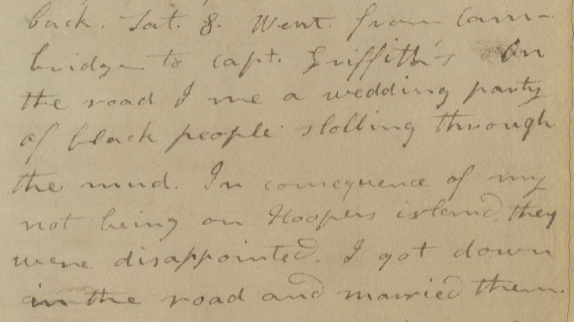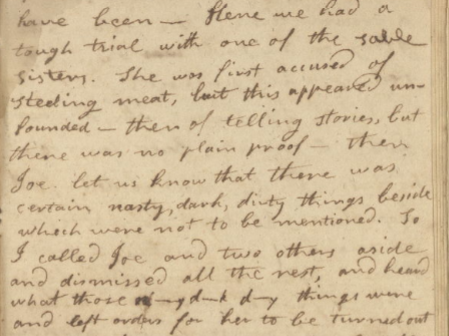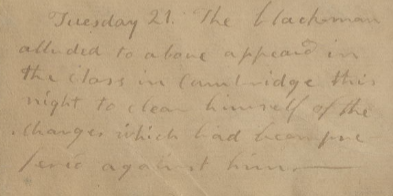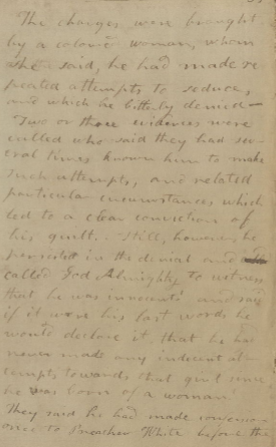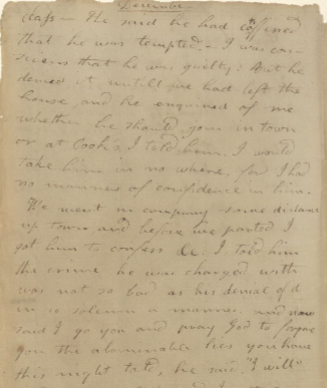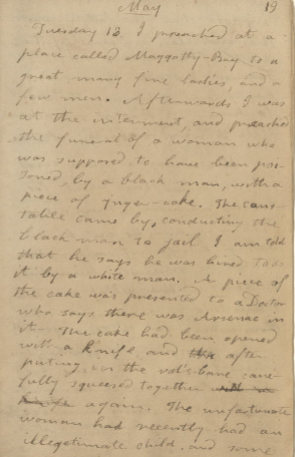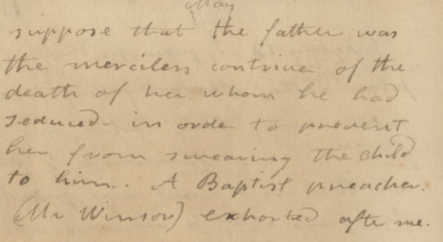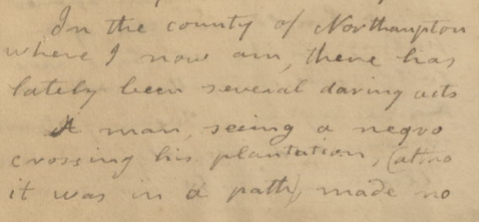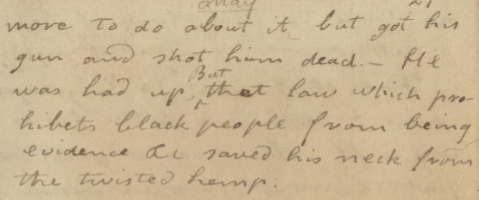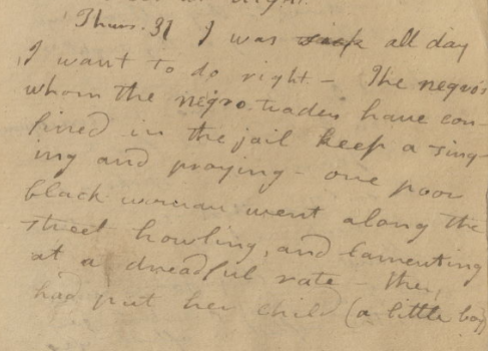This manuscript contains many accounts of Swedish settlement along the Delaware River from the early 17th century to the mid-late 18th century, including the relations of Swedish settlers with the Delaware Indians, from whom they bought land and with whom they traded. The following are selections from the text.
The Case of the Missing Document
It can sometimes be instructive to compare early translations with later ones, as with an account of the lands granted to early Swedish settlers by the Delaware Indians. The original Swedish text appears in images 3 and 4. Reverend Andrew Rudman, “founder and first Rector of the present Church at Wicacoa, stiled Gloria Dei” provided this translation in April 1703: (Image 41)

A ship called the Kej of Calmar, was fitted out from Gottenburg, with people and necessaries. Menive was appointed commander of the colonists. They arrived safe, obtained from the savages a grant of land on the river, from the mouth of it to the falls and there fixed stakes for marks. The old people informed me that they often had seen these. The purchase was formally stated in writings, under which the Indians put their marks. The document was sent to Sweden, and preserved in the archives, when I was at Stockholm.
The later translation that accompanies the original Swedish (again, starting from image 3) was imported from Colonial Records of the Swedish Churches in Pennsylvania, which was compiled from 2006-2021 by Peter Stebbins Craig, Editor and Kim-Eric Williams, Assistant Editor.
The chancellor, Count Axel Oxenstierna, who as their leader, spoke to Queen Christina, who was so pleased with the proposal that, through her order and permission, a ship was sent from Gothenburg called the Calmars Nyckel [Kalmar Nyckel], with a number of people who arrived safely and negotiated with the heathens for the land from the mouth [of the Delaware] to the falls [at Trenton]. There they erected some poles, which the old people, when I first came here, often said they say, and which they took care of. They meant that they could still be found on both sides of the River, all of which land was purchased from the heathen and deeds and agreements made, to which the heathen either put their signatures or marks. The document was sent back to Sweden and when I was in Stockholm was in the [Royal] Archives. It is a shame that no witnessed copy is to be found here, which was certainly written, but because of so many revolutions was lost. When [Governor Johan] Risingh and [Peter] Lindestrom came to this land [1654], they had with them the names of those who had signed the agreement. The heathens who lived then recognized them [for the other were mostly deceased; if I remember rightly, all except for one]. But the Indians do not want to hear their names mentioned any more because their custom is still not to speak of the name of the dead.
The Tale of the Mercurius
Andrew Rudman’s translation (image 42,) original Swedish with later translation (which is much the same) on image 8.

After the loss of the colony, in the year 1656, a Swedish ship called Mercurius, arrived in the river. The Dutch would prevent its going up. But the Indians, who loved the Swedes, went on board, and in defiance of them conveyed it by their fort. Among the passengers was Andrew Bengtson, Sen. yet living, who this day of April 1703 gives me this verbal account.
Positive Relations with Native Americans
It was important to Swedish settlers to record their good relations with the Delaware Indians; they did so many times throughout the text.
Images 16–17, Regarding John Prinze, “stiled Governer of New Sweden,” 1642:

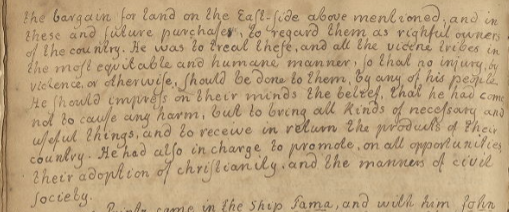
“Respecting the Indians The Governor was directed to confirm directly after his arrival, the treaty with the indians, by which they had stipulated the western shore of Delaware from the Cape Hinlopen to the Falls Sanhickans, and so much inland as gradually should be wanted; also to ratify the bargain for land on the east-side above mentioned; and in these and future purchaser, to regard them as rightful owners of the country. He was to treat these, and all the vicine tribes in the most equitable and humane manner, so that no injury, by violence or otherwise, should be done to them, by any of his people. He should impress on their minds the belief, that he had come not to cause any harm, but to bring all kinds of necessary and useful things, and to receive in return the products of their country. He had also in charge to promote on all opportunities their adoption of Christianity, and the manners of civil Society.”
After Prinze left, he appointed his son-in-law Pappegoia Vice Governor, who in turn left after two years, turning over the government of New Sweden to Reising, who took the title of General Director. Also image 17:

“Soon after his arrival he invited ten of the indian chiefs to a meeting. It was held at Tinicum the 17 of June 1654. He saluted them from the Swedish Queen with assurance of her favour put them in mind of the purchase of the lands already made and requested a continuation of their friendship. He distributed various presents among them, and gave a good entertainment to them and their company. They were well pleased, and assured him of a faithful affection.
Image 24 English, Image 21 Swedish – circa 1693:

We live also in peace, friendship and amity with one another, and the indians have not molested us for many years.
Image 47 – Additional Remarks by the Translator (Andrew Rudman, circa 1700):

“The conduct of the Swedes towards the indians was very prudent and friendly, by which they gained their good will and respect. Without this the first settlers being few might have been cut off and must even after being reinforced, have run great hazard. The instruction to governor Printz provided how carefully they should be treated. Being attached by kindness they were also awed by the military attitude of the Swedes. An example of this happened in 1645: They were discontented because the vessels carrying presents and good for traffic had not arrived, and their chiefs called a convention to resolve on war or peace. After a warm debate it was deemed best to continue in friendship, because the Swedes were good people and brave warriors.”
Image 156 English, Image 101 Swedish:

In the year 1715 The Indians on the borders of the Mississippi in South Carolina, of diverse tribes some thousand in number collected and killed hundreds of the Christians before they knew of it or could resist. At last one of these who notwithstanding, his being wounded, happily escaped and made their cruelties known to the inhabitants of Charleston. On this information all the inhabitants of the adjacent Country fled from their homes to Charleston but as that Town could not contain them, they took passage in the Trading vessels. Some went to Barbados others to New England and Philadelphia. This calamity was occasioned by some of the Traders that had dealt with the Indian tribes in a fraudulent manner. Those Indians however who lived here abouts have during the whole time of my ministry conducted themselves peaceable, so that we have always lived on friendly terms with them, and they on the other hand, have frequently renewed their treaty of alliance with our sovereign.
Indian Catechisms
I was curious to come across the following references to “Indian Catechisms.”
The page reproduced in image 28 is in Swedish, and the only English translation is the text imported by the book by Craig and Williams, referenced above.)
The blessed King showed us more than Royal Grace, called us into his chmbers, and asked us if we needed anything, and that if anyone had put obstacles in our way we should go immediately to Him and to no one else. We were delayed also because the Indians’ Catechisms’ were being printed and we had to wait for them.
The page reproduced in image 30 is likewise in Swedish with the newer translation accompanying:
And in like manner we receive too copies of the American (Indian) Catechism, which we received bound in brown leather with gilded edges and the King’s Coat of Arms gilded on both sides. And what is more we certify this with our signatures. Dated in Stockholm the 18th of July in the year 1696.
The “Additional Remarks by the Translator” (Rudman) in image 33 clarify:

The Indian catechism was composed by Campanius for the instruction of the Indians. It had not been printed in America, for want of convenience, and as the manuscript was for sufficient. It is the short catechism of Luther, in Swedish and Indian. The explication is, in proper cases adapted to thye manners of the Indians: for example daily bread is plentiful supply of venison and maize.
A copy of this catechism, held by the University of Pittsburgh, has been digitized by the Biodiversity Heritage Library, and can be viewed online here.
A selected illustration from the Indian Catechism:
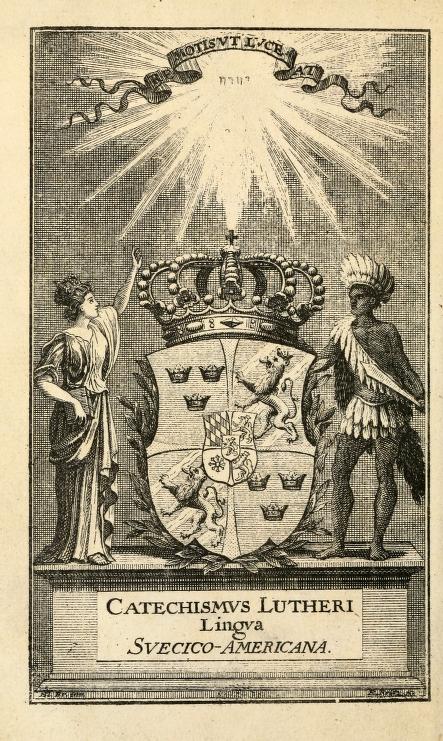
The cover of the above volume is a obviously a rebinding, however, a copy up for sale for $2196 at Bonhams may have the original leather cover, although the gilding of the coat of arms has disappeared since 1696.

Note from historian, archivist, curator and translator Kim Eric Williams: “Copies of the Indian Catechism are to be found at the American Swedish Historical Museum and in the Krauth Library of the United Lutheran Seminary, both in Philadelphia. A reprint is widely available and was printed in Stockholm in 1938.”
